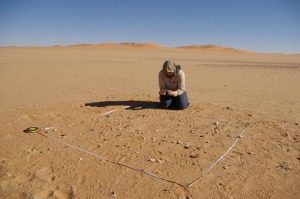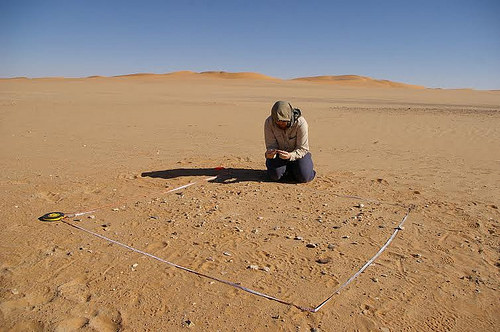
Long gone are the days when scientists asserted that ancient humans could not possibly cross through and inhabit the harsh world of what has historically been referred to as the Arabian Desert, including the Empty Quarter of the Arabian Peninsula. Traditional theories depicted groups of early modern humans first dispersing out of northeastern Africa north and east through the Levant and then northward into present-day Europe and through northern routes into India and then the Far East. Additional dispersals took them along routes hopping the coasts of Arabia and then coastal across India, then further northward and eastward. These models of early human dispersal avoided the Arabian interior, as few could imagine humans making their way directly and deeply into this desert no-man’s land.
But remote sensing technology, including satellite imagery, has now placed Arabia squarely on the map of early human dispersal paradigms. Recent studies using this new technology have reported ancient systems of lakes (‘paleolakes’) and rivers—green zones—deep within the Arabian desert regions as much as 100,000 or more years ago. Archaeological investigations at some of the ancient lakeshore sites have yielded human stone tools, some of them dated back even earlier than 100,000 years ago.
___________________________________________
Dr Huw Groucutt (University of Oxford) systematically collecting a dense scatter of artifacts on the shore of an ancient lake dating to around 85,000 years ago at Mundafan, southwestern Saudi Arabia. (credit: Richard Jennings/Palaeodeserts Project) From the article, The First Arabians, published in the June 2014 issue of Popular Archaeology Magazine.
___________________________________________________________
Were the makers of these tools anatomically modern humans (AMH), or were they other species of humans, such as Neanderthals? The absence of fossil evidence at these sites leaves this critical question unanswered. But research continues, and scientists hope that one day field investigators will come across the fossils that will provide the tantalizing ‘smoking gun’. Meanwhile, researchers are busy refining and expanding their knowledge of the ancient green environments that provided the livable backdrops for the migrating animals and the humans that followed them on the hunting trail. The lithic (stone tool) evidence has been mounting, as well.
Popular Archaeology has just released the summer 2014 article on this topic, entitled The First Arabians, as a free article now available to the general public. It contains detailed, in-depth interviews of some of the key players in the ongoing research of the sites on the Arabian Peninsula.
__________________________________________________________
In addition, the latest Popular Archaeology ebook is now available.
______________________________________________
Travel and learn with Far Horizons.
____________________________________________
This richly illustrated issue includes the following stories: Two remarkable discoveries that are shedding light on human beginnings in Africa; a traveling exhibit and an archaeological site that show how knowledge is more valuable than gold; a Spanish cave and a unique burial that are offering a tantalizing glimpse on the lives of Ice Age hunter-gatherers in Europe; the stunning visual reconstruction of an ancient Roman town; enlightening new finds at a remarkably well-preserved site of ancient Hellenistic-Roman culture overlooking the Sea of Galilee; rare finds that are shedding light on occult practices among ancient Greeks in Sicily; and an overview of the overwhelmingly rich archaeological heritage of Britain. Find it on Amazon.com.










